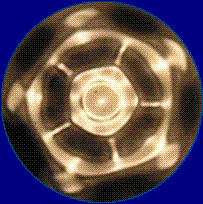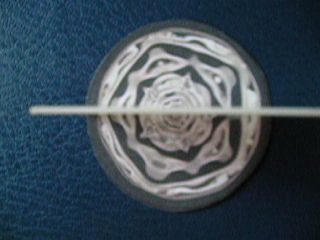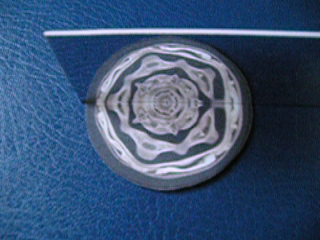Geometric Regularities
Concentric circles
Out of the midpoint of our circular water surface arise a hill that grows out as a circular wave, followed by new circles, all around the same centre.
When they reach the outside border, they reflect, and move back to the midpoint.
So, of course, they will meet the out coming circular waves... and will interferere.
Equal radial division
This is schematicaly what you see with the naked eye. On a photograph there is much more to see, especially between these radii, as we will see on the images in the photoseries.
Regular Polygons
The intersections of this radii with the circle form the vertices of a regular polygon. Although we do not often see the straight sides of the regular polygons in a watersoundimage, regular polygons have many geometric properties that we will find also in our watersoundimages.
Let's explore them.
All the sides of a regular (convex) polygon have the same length, and all the angels are equal.
You can construct one circle through all his vertices, a so called circumscribed circle.
The distance from the midpoint perpendicular to the polygon-sides are the apothems, all equal. They form the inradius of the polygon.
Through those points we can construct a common, in(scribed) circle, touching the midpoints of the polygon-sides.
Polar Polygons
Connecting these points creates a new polygon, with equal number of sides and vertices as the original. He is nested in the first one. He is otherwise orientated.
When we elongate all the apothems until they meet the circle, those intersections lie between the vortices of the original polygon, right in the middle.
Connecting them gives the same polygon, but again in another position: his vortices lie as far away as possible from the first one's.
In this sence we can say they are orientated in an opposite, polar position.
In watersoundimages we can see those polar orientated polygons like this:
When we look to this on odd-numbered polygons then we see that one radius (and his vertex) points down, and in the next faze right up.
In even numbered regular polygons, the next faze points out just half between the radials of the previous fase.
In a watersoundimage we see identical, polar orientated structures alternate.

In the images and films you will notice those polar polygons in different ways:
- standing nested (alternated in the same image);
- growing nested, between in- and circumscribed circles;
- alternating after each other in time.
Here you can see how out of a row of concentric circles generates a series of polar polygons, between those circles alternating as circumscribed - inscribed. Wonderful how this can happen, because the distances between the circles has to be exact so that all the alternating polygons fit in and arround their circles! Only then this all fits excactly...
We notice that the radials from one fase situate at the same location as the apothems of the polar fase, and vice versa.
Symmetries
A geometric analyze of the symmetry-properties in regular polygons you can search for on the internet. Here I suggest a practical investigation.
Mirror symmetry
Put a frameless mirror perpendicular on a (printed) waterssoundimage, over the centre. Rotate the mirror around (keeping him over the centre). You will notice that, when the mirror is aligned with a radius and/or an apothem, the pattern in and behind the mirror is similar.
Look to the image in the mirror, then over the mirror to the picture behind him. The part before the mirror joined with the part behind is equal to the whole image, the mirror did not change it.


While filming I moved the camera from above the mirror (first image) down, so you can see the mirrored part completing the total picture (second image). Have a look...
In odd polygons two opposite radii are in each others extension, in uneven polygons each radius lies in extension with his opposite apothem. So each radius is a mirror axis, just as every apothem.
So there is reflection-symmetry in all these axes which pass through the center.
In even polygons half of these axes are formed by two opposite radii (connecting opposite vertices, a diameter), half by two opposite (extended) apothems (inradii).
In uneven polygons all the symmetry-axes are formed by a radius and his opposite apothem, connecting a vertex with the midpoint of the opposite side (and elongated to the circle) .
This means that every n-polygon has n symmetry-axes:
- a digon (2 equal segments) has 2 (not always regarded as a regular polygon,occurs nevertheless in watersoundimages);
- a triangle (equilateral) has 3 reflection-symmetry-axes;
- a square has 4, a regular pentagon 5, a regular hexagon 6, a regular heptagon 7, etcetera.
- In general: an n(poly-)gon has n mirror-symmetry-axes.
When you have observed this concerning the total image, let us look at the single sectors (pizza-peaces): a radius mirrors a sector right on the adjected one, so all the sectors are the same, similar in shape and form. More than in simple regular polygons, this happens to be true for these regular watersoundimages, while also the patterns inside the sectors are identical with those in the other sectors!
Then we notice that one sector is devided by his apothem in two symmetrical peaces, in a watersoundimage included the pattern within!
Rotation symmetry
When you cut one sector out of your (on transparent paper) printed watersoundimage, and rotate it (with the center fixed) then it converges on a certain moment with another sector, and you will notice that they are, also in his way, identical, included the inner structures.
It is not self-evident that this rotation-symmetry and the mirror-symmetry coincide: this is because the apothem divide a sector in symmetrical halves.
Inversion-symmetry
The center of our images is perhaps an inversion-point, as we discussed on the page about the periodic regularities ... This has to be investigated further.
Eventually you can simulate a few of these actions on your computer, but realize yourself that doing it by your own hands and seeing it happen is the real thing. A computer does this on an other way, a simulation does not give the same experience as when you see it happen with a real mirror.